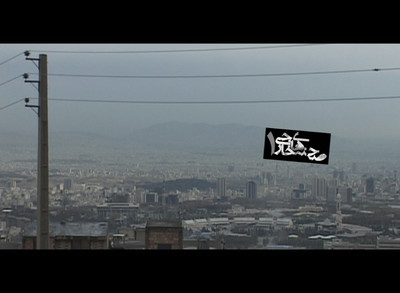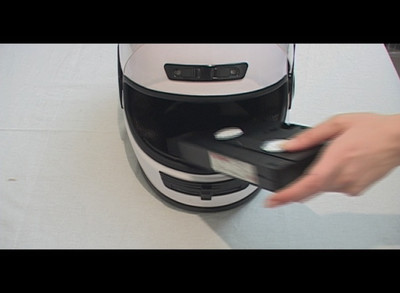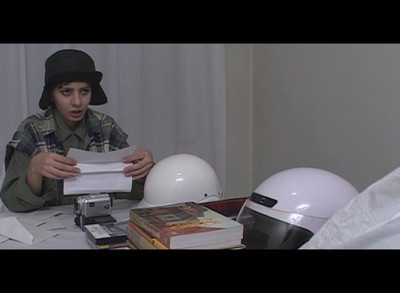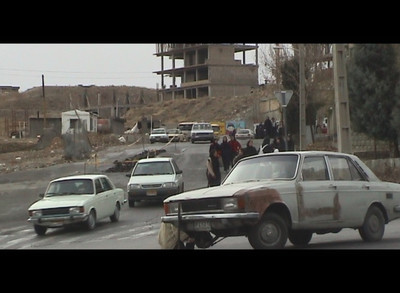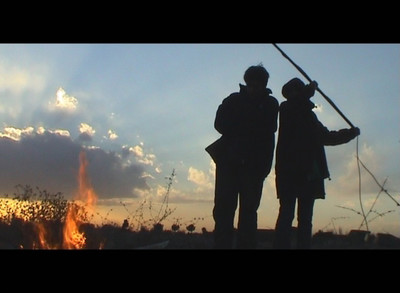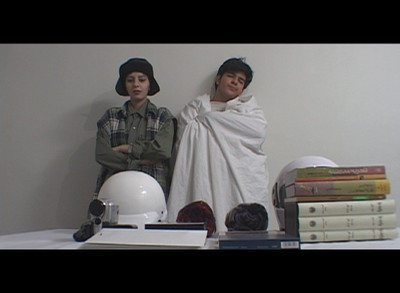Below is a discussion between filmmaker Alireza Rasoulinezhad and scriptwriter and film critic Shadmehr Rastin. Their discussion revolves around a recent film by Rasoulinezhad called Exteriors.
Exteriors – a one hour and twenty minute film shot on video – is a satire in three episodes about a disillusioned intellectual who disappears from Tehran to lead a different life elsewhere. He leaves his apartment to his nephew and niece, Shayan and Sharleen, with instructions and notes on various social and cultural topics and an unfinished film. Inspired by their uncle’s ideas and his film footage, they decide to make a film together; a decision that sets the ground for their (and our) encounter with the depths and facades of the social, cultural and political complexities of Tehran. What the film shows us is a kaleidoscope comprised of self-invented orientalism, performative traditionalism, intellectual turmoil, and a genuine strive for change. (Pages)
Shadmehr Rastin: The film Exteriors suggests to the audience that they could understand Tehran by looking at the city from a different viewpoint: a kind of liberation from ingrained habits that gives us a new understanding.
Following their uncle’s advice the two main characters use the camera as an instrument to reveal their identities. Giving the camera to the two characters is very interesting, it’s as if you told them to deliberate while observing and to re-view what they’ve seen through the medium of cinema; a kind of expression of personal opinion along with a tolerance of other people’s opinions. As if you told them to look at the city and their situation in order to get to know them selves.
Alireza Rasoulinzhad: Cinema is basically an urban phenomenon, in this film cinema and the camera are introduced as instruments to perceive the city. The experience of living in Tehran is unique and crazy, citizens can’t comfortably walk beside each other. One of the ideas in the film is of looking at city and ‘citizens’ in a specific historical situation. The film tries to address the chaos of different aspects of modernization in the public domain in Iran, during the screenwriting and the making of the film I was looking for ways to prevent the film’s form and structure from becoming disorderly. I was trying to define the disorderliness of the experience of Iranian modernity for myself. It was an attempt to present a musical and cartoon-like account of the existing situation. Employing devices like narration, speaking into the camera, jazz music resulted in a parodic and casual tone.
SR: Although the title of your film is called Exteriors, it doesn’t actually show many outside scenes and public spaces of Tehran. Or maybe I feel this way because the public and private spaces are so intertwined in the lives of Iranians. Your film is a reflection of the merging of these two spaces, resulting in the disappearance of their differences. It considers this merging as an historical and deeply rooted condition.
Through the persuasion of the Safavid dynasty the private practice of religion turned into a kind of public demonstration. The need to perform worship became more important than worship itself and since then the function of performance has changed in Iran. It’s in the sphere of public performance, therefore, that we express our internal characteristics. Your film does not deal with religion but all the external reactions of citizens in the city that become their self-expression.
If you take a visit to The Martyrs’ Lot of ‘Behesht-e Zahra’ (Tehran’s cemetery), you’ll see that each of the framed pictures and epitaphs represents a personal attitude. It is the family members’ perceptions of their martyrs that present how they wish them to be remembered, and they show that most emphatically through pictorial representation. The same is true for the facades of buildings in Tehran. You can’t see any two buildings in an alley that are the same, unless they are designed by the same architect. What you do see is some kind of disorder. But, I’d insist it’s not a chaotic disorder.
In Tehran interior and exterior are somehow intertwined. I mean, while public and private spaces are merged, the inside and outside of people, the buildings, and even protagonists in the feature film overlap, revealing a new concept typical to today’s Iran. In a typical TV series, women, alone at home wear the same kind of authorized dresses as they do in public spaces. In Exteriors there is a scene in which one of the characters puts a blanket over his head to isolate himself, like a Gnostic, in order to suggest the notion of the city. Here again, I’m reminded of the entanglement of the internal and external in Iranian society, which in turn requires some kind of reflection and understanding.
AR: Some of those who have seen the film found it too typical of Tehran and say you have to live there to get a better understanding of the film; the film mainly deals with the problems of Tehran’s citizens. There are different variations in the film circling around a central theme. In a very general way this theme may be the experience of Iranian modernity. I didn’t enter the domain of religion and didn’t give an account of its transformation in an Iranian metropolis. Nevertheless I give some indications. For example, I show mosques and their function in the present situation. In newly built mosques you don’t see much of the architectural elements of a mosque in its classical sense as a place for worship. In the Aljavad Mosque, in Haft-e-Teer Square for example, you feel like you entered an administration building. In the Tehran of 2006 mosques have also found some additional functions.
In my film I’ve tried to show different aspects of the metropolis and its modernization, our position in the first decade of the new millennium and the circumstances we’ve created. The film deals with our essential relationship to modernity, how much information we have and what we’ve done in the public domain. Iran has been among the first countries in the Middle East to be interested in modernity over the last 150 years. Since our constitutional revolution we did a lot of things based on our interest in the West. We read through a lot of things and picked what we liked. The experience of modernity in developing countries is odd and wild. The film says: “wait a minute, stop and look at the status quo.”
SR: In the film, the uncle dictates the conditions that the two protagonists accept. At this point we’ve a classical story pattern: there are two people who have to make a series of attempts to achieve a goal. It does not matter whether they pass the stages very well or heroically, what matters is the effect of passing each stage and going through the entire thinking process with the characters. You combined the classical scenario model with the rhythm of a modern one, which is based on overcoming obstacles.
AR: Of course, these two are not characters, rather they are stereotypes originating from cartoons. The pattern of the film is not based on characterization. A narrator describes the people in the film in a cartoon-like fashion. The pattern is descriptive; it does not deal with motives. Shayan and Sharlyn fluctuate between stereotype and character.
SR: Now we should ask what the destiny of cinema is in modern Iran?
Iranian post-revolutionary cinema, coinciding with the ready availability of digital cameras, provided the possibility for everyone to depict their immediate thoughts. We used to say: “if you want to know someone, see what books they are reading, or who their friends are.” Now it seems it’s changed to: “if you want to know someone, see what films they’ve made.” It’s as if cinema has become a medium for fulfilling our needs, especially for the young generation.
In fact, post-revolutionary filmmakers under the age of thirty show all their needs and demands in their films. They don’t say what they think, or what theories they have; they only say that they need this or that. The young cinema of Iran is the cinema of objection.
Each year 2000 feature, documentary and experimental films are made in Iran but all in all no more than 600 are authorized in Tehran and other cities. So 1400 films are made without authorization.
The amount of digital production is comparatively larger. According to the latest official statistics, each year 1400 short films, half-length, features, animations and documentaries, averaging 20 minutes in length, are made. You can’t find more than three or four that are different, mostly social topics in all those 28 thousand minutes of film. The young makers of these films prefer themes such as religious ceremonies of Ashura and Tasou’a, miracles, and superstition or concise stories happening in a closed internal space, usually with an indirect tendency towards eroticism.
Naturally, when a few young people are inside the closed space of a home they are inclined to break a taboo. The involvement of a character with public space constitutes the smallest part of the story. The young filmmakers become either holistic or totally atomistic in describing public spaces. A young person has to show themselves differently in public vs. private spaces. Therefore, a young filmmaker with a camera in hand shows what they would like rather than what they are.
As for the documentaries, we have 1000 each year, but even with this number we fail to clearly define our social issues. It usually matters more to us who made the film than the film itself. Most of them turn out to be documentaries about the filmmakers and not about society.
AR: At any rate, 2000 filmmakers for a country like Iran is an anomaly in itself. Paradoxically, because of the lack of civil institutions and other problems, suddenly a lot of people appear in the field of filmmaking wanting to make films. The reason – apart from the attraction of the cinema and its representational aspect– is that making films is cheap. Most directors of short films have editing equipment at home and it’s very cheap to rent a camera. With a little money you could make a short film with your friends and it might be shown at a festival very soon. The only hope is that all those filmmakers gain experience in the present inexpensive situation. It is a good chance for one to practice as a filmmaking because nobody knows for how long the low-budget conditions will last..
SR: Of course these are the external causes. The internal part is that following the revolution young people have not had the space for self-expression. There is no place for them to find themselves. So, when asked: “What do you do?” or “What is your job?” one of the best personal expressions is “I am a filmmaker.” That can work as an identity card. Cinema involves publications, advertisement, communication and foreign and international festivals. These factors motivate a young person to say: “I am a filmmaker”. This is why the “I’ve got a camera therefore I am” attitude is prevalent – more so since the advent of a digital camera.
Exteriors could have been 6 short films and now you had finished your sixth film. However you made a long film, but then could not produce anything for 2 years. Of the 2000 films mentioned above more than 60% are no longer than 13 to 20 minutes. No TV network buys such films. In the end these films are not shown more than once or twice. A young filmmaker will never invest in a long film. Nobody would be ready to spend so much energy and resources. They prefer to make inexpensive less time consuming films with attractive themes. Exteriors is in this respect an exception in Iranian cinema. Yet we don’t know what the filmmaker’s next project will be. That does not say anything about the filmmaker’s state of mind but rather about the unstable circumstances of filmmaking in Iran. The circumstances keep the filmmaker in a constant state of transience.
AR: In fact, Exteriors is among the scant number of films in the private sector that’s made without government sponsorship, and yet it was shown at the state festival of Iranian cinema (Fadjr Film Festival). However, it doesn’t seem to have been too attractive to foreign festivals. Perhaps those festivals are more interested in particular issues such as bisexuals, slum-dwellers, women, children, … And as you might know, many festivals are supported by charities and civil institutions that care for such issues. If you take your camera to a courtroom dealing with women’s issues, your film will certainly be received by some festivals, even if it’s badly edited. But if you deal with Iranian issues in a parodic way they don’t find it too interesting. That is because foreign festivals haven’t had much experience with urban life in Iran through cinema.
SR: Some say that foreign festivals are changing the direction of Iranian cinema. That is true of course – many filmmakers make films for five-day festivals and go for themes that are suitable to foreigners. For some time one of the hottest themes for documentary makers in Iran was bisexuality. Trans-sexuality was another ‘issue of the day’ at one point. We were frequently called from abroad and asked for such themes. Since Iran is a religious country foreigners are curious to know how it’s possible that some people can actually undergo sex change operations in a country that denies sex. While, in fact, Iran is one of the least difficult countries when it comes to sex-change surgery or issuing revised identity cards. What annoys those transsexuals is not the government but the reactions of society and that is what foreigners would like to discover. Of course they don’t discover anything about the society – and they don’t bother to try; they just look for the sensational aspect of the issue.
This touristic view of Iran is, little by little, influencing the filmmakers so that they seem to be adopting the same touristic approach towards their own country – this is superficial and just scratches the surface of the issues. To get involved in any genuine analysis would take time, and the problem is nobody has enough time.
Before the revolution there was a mainstream cinema in Iran that became known as “FilmFarsi”, where films were made without inspection or subsidy by the ministry of culture and without being broadcast on television. This kind of film had to compete with foreign films. The pre-revolutionary Iranian independent cinema, unlike the private sector cinema, was based on European cultural policies – mainly French cinema – and was supported by the government. In those days the policy, like in many European countries, was to support non-commercial productions.
Post-revolutionary support for independent films requires them to be profitable. That is, only a film with good box office returns would be supported. This is a remarkable paradox. Unsupported films never have a chance of being broadcast on television – television is even less innovative than commercial cinema. And within the very domain of cinema there has occurred a phenomenon that could be called “the reign of the silver screen owners.” The owners of cinemas have the last word and determine everything. It is the owner who decides which film should or should not be shown. The owner would never go for the experimental stuff, he prefers to stick to already established types of films that guarantee profit.
AR: Since the digital cinema arrived a lot more experimental films have been produced, some of these are seen and some are not. The question is: what position do these films have in terms of critique and analysis? If experimental films are not publicly shown, we should at least review them during private screenings. Many people don’t have any idea what such films are like. There are still more filmmakers whose films are neither seen nor reviewed. I believe there has been little discussion about experimental films in the sphere of Iranian cinema. By contrast, a film like Exteriors seems radical and experimental. The filmmaking tradition applied to this film stems from a few decades ago. But, since there have not been many such films in Iran, Exteriors seems radical and experimental.
SH: However, although the experimental films have had the lowest number of viewers in Iran they’ve been the most influential over the past 10 years. The most persistent defenders of the screening of Exteriors were officials of the Fadjr Festival and the Ministry of Islamic Guidance. They’ve come to know that Iranian cinema needs novelty and innovation. Exteriors has three distinctive characteristics: firstly, its modern form and new narrative structure, compared to the classical structure which dominates cinematic expression in Iran; secondly, the realistic depiction of the Iranian middle classes. Due to the limitations and application of tastes prevailing in Iranian filmmaking since before the revolution, Iranian films either show society as one-dimensional or tend towards fantasy when expressing social issues. To put it concisely, Iranian films often fail to present a proper image of Iranian society. The third notable characteristic of Exteriors is that it has entered the new field of minimal-cost production (in addition to the social limitations Iranian filmmakers have traditionally been faced with – the shortage of funds and lack of technical and studio facilities). Therefore an experimental and low-budget film is an ideal case for the Iranian cinema officials
AR: Making Hollywood-style films is an object of desire in Iran. Iranian cinema has always yearned to be able to make a standard classical film comparable to Hollywood, in terms of the style of production, scriptwriting and screening.
SR: Both filmmakers with cinematic education and those who learned to make films through experience follow the example of Hollywood. Yet they wouldn’t like to say they’ve made an industrial film. They would rather like to say they’ve made an art film – like Bergman or Bergson for example. That’s a paradox.
Abbass Kiarostami once said that since the Islamic revolution the whole society has been chanting anti-American slogans and demanding self-sufficiency in every field from industry to agriculture, while many filmmakers have been insisting that Iranian cinema must be Hollywoodized (i.e., Americanized). Most of our filmmakers would like to follow the production style of America. They don’t look for alternatives. They don’t go for experimentation, the lack of facilities and problems of production and distribution discourages them.
Exteriors is a novel experience expressed in a satirical tone similar to Woody Allen or Martin Scorsese. Unfortunately it never got to public screening. Cinemas didn’t welcome it because they believed that it wouldn’t even cover its publicity costs. The main problem here is that there is no control on ticket sales. As a producer you will not find out how many tickets are sold each day. Distribution here is a wholly other complex story.
AR: Regarding all the problems of alternative cinema (problems of screening, government policies for distribution, disruptions of mainstream cinema, etc.), it was clear that there wouldn’t be widespread publicity for a film like Exteriors. One could only expect it to be shown, for example, three times a week in a cinema for a specifically interested audience. It was, however, even denied such a limited screening because some people are concerned that experimental cinema might override the other types of cinema and take over the market – while in the real world it enjoys neither profit nor audience! And this is while, as you said, the cinema system is not aware of the number of the tickets it sells. It does not have the most basic information about its own mechanisms. This is because the system is somehow government-related. Where the whole process, from production to distribution to approval of scenarios to the allocation of funds takes place under the authority of the government, everything goes on bureaucratically and a lot of energy is wasted.
Here in Iran a large portion of the population, a few million people, never go to the movies. The system – the Ministry of Islamic Guidance, and the policymakers – can’t work out why. I think apart from the reasons such as the lack of a sufficient number of cinemas, the concentration of cinemas in the center of the city, or the growing tendency to watch films on DVD at home, we might also assume that many people basically don’t approve of Iranian cinema. They don’t like the dialogues, stories, and spaces of the films. People don’t see images of their own lives, of the things an inhabitant of a metropolis is involved in – the urban experience. We never, or rarely, see an urban experience in Iranian films. In the plots of Iranian films people who live in apartments are still involved in provincial problems.
SR: We also need to check out the instability of the production process of Exteriors. From the first day to the last the definition of the producer’s role was being changed. Directors have to be aware of changing producers. Producers are changed every 6 months in Iran. They should also be aware of the instability of the audience, which is changing rapidly. It’s hard to tell what the taste of people is. Now, if someone wants to make a film under such volatile conditions, how does he go about it?
